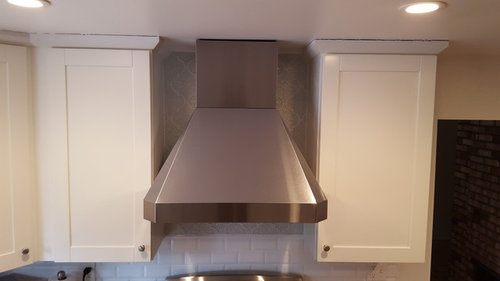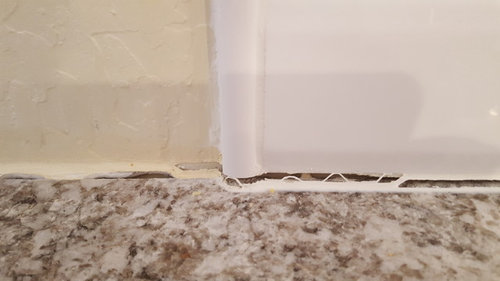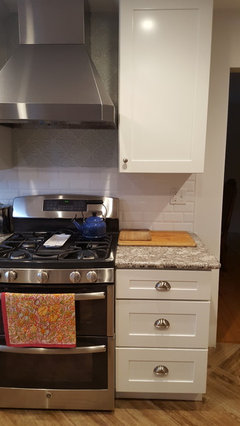SEVERE cracking in newly remodeled kitchen
8 years ago
Featured Answer
Sort by:Oldest
Comments (36)
- 8 years ago
- 8 years agolast modified: 8 years ago
Related Discussions
Bar needs design
Comments (270)Hi chook! Just a quick pop in to see what's going on and I see where your daughter is getting a new bed. It is very nice and she will love it, I'm sure. So glad you got the winning bid! Exciting, huh? Talk later. :)...See MoreWhich style era could you never have in your house?
Comments (79)Oh C'mon V Richards...every epoch has its treasures. B4 you make a mad run for it stop a while and consider the period and the reasons for the style...it can be extremely enlightening....unless its not the period you want to escape from but from some of the opinions. I spent many years of my youth outside of Australia living surrounded by old ruins in Europe. I forgot what it was like here. When finally I returned to Australia and found myself living in some of the 60s and 70s places..I found much to admire and wonder about. I may not have fallen in love with much of it but there was a certain mistique and a feel that I can still conjure when talking about certain places. Not saying that it was all romantic and pleasant but it conveyed something of the era and the kind of Aussie from those days....See MoreWhat do you wish you knew before moving into your current home?
Comments (62)@Karen Hodge, I hear you!! Sometimes I think the estate agent should carry quite a bit of the blame actually. If they do their job correctly like you see in the adds on TV, they should bring these discrepancies to the attention of the sellers, stand on their morals and say if you can't get it better than this, then you'll have to find someone else to sell your home!! I know you can't make everybody "house proud" but the saying "do unto others" springs to mind. I bet if these same people bought a house not up to scratch, "a current affair" would hear about it but they don't think it wrong to simply walk out on a house that isn't being left nicely for the next family!! I have some friends that recently sold a house in Essendon, Melb and whilst the buyers were back and forth selling their own home, my friends kept watering the plants and even did things like painted out the wardrobes because of the scuff marks made over time!! They cleaned the entire two storey house from top to bottom and finished by mopping the floors as they were exiting. The buyers were so taken by the entire home, they bought it with almost all the furniture that my friends had in it!!...See MoreWhat do you think of this floor plan for a new build?
Comments (103)When I first wrote in August 2017 we got a lot of great suggestions and comments. At the time we had accepted the limitations of the block (easements, tree, solar access etc). It is now one year later and I can tell you we found a way to move the garage to the south-west corner. This allowed us to move Beds 2 and 3 and the bathroom to the northern side. Pantry and laundry between garage and kitchen/living/dining. I think it was all of the comments and suggestions that encouraged us to look at it again from different angles, rather than just accepting the limitations. Thanks to everyone for their generosity! The solution involved working around a lovely tree (it is nice, just in the wrong spot). It is still in the way (council said we couldn't remove it) but we've opted for a long, curving driveway that starts on the other side of the block and weaves its way around the treeline to the garage entry. Not ideal, because a large portion of the front setback will now be a hard surface, instead of a garden. But if there is one thing that designing teaches you - its all about compromises. Thanks everyone. MB Design & Drafting Shara C Nik Star girlguides oklouise siriuskey genkii saragraham76 Andy Pat brizcs Mel N 3D Home Concepts suancol Caro...See More- 8 years ago
- 8 years ago
- 8 years ago
- 8 years ago
- 8 years ago
- 8 years ago
- 8 years ago
- 8 years ago
- 8 years ago
- 8 years ago
- 8 years ago
- 8 years ago
- 8 years ago
- 8 years ago
- 8 years ago
- 8 years ago
- 8 years agolast modified: 8 years ago
- 8 years ago
- 8 years ago
- 8 years ago
- 8 years ago
- 8 years ago
- 8 years ago
- 8 years ago
- 8 years ago
- 8 years ago
- 8 years agolast modified: 8 years ago
- 8 years ago
- 8 years ago
- 8 years ago
- 8 years ago
- 8 years ago
- 8 years ago










Sukenick Architecture, LLC